Notes: Living World | Science & Pedagogy Paper 2 for CTET & TET Exams - CTET & State TET PDF Download
| Table of contents |

|
| Attributes of Living Forms |

|
| Classification of Living World |

|
| Classification of Kingdom- Plantae |

|
| Parts of the Plant |

|
| Classification of the Kingdom Animalia |

|
The living world is made up of a huge variety of life forms that are connected through things like how they are classified, their outer appearance, and their inner body systems.
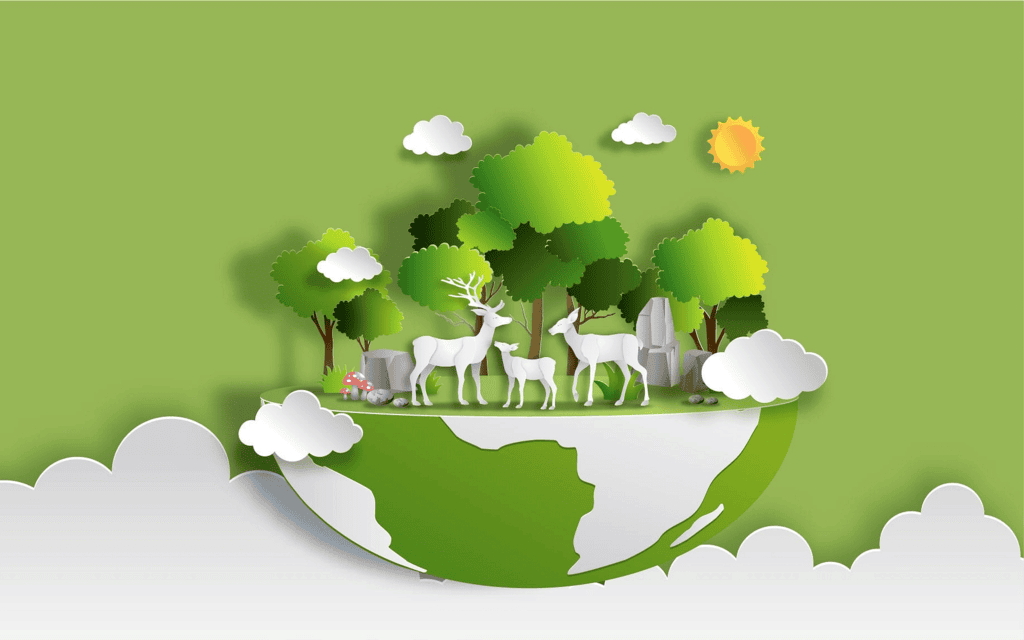
Biology is the science that studies life and living organisms. The word comes from two Greek words: 'bios' meaning life, and 'logos' meaning study. Aristotle is considered one of the early pioneers in the field of biology. Life is what sets living things apart from non-living things. Living things are called animate, while non-living things are called inanimate.
Attributes of Living Forms
1. Cellular Organisation
This refers to how cells are arranged and organized in the bodies of living organisms. Cells are the basic building blocks of life, and their structure and organization can vary widely among different organisms.
2. Growth
All living organisms grow by increasing their mass and the number of cells they have. Multicellular organisms, which are made up of many cells, grow by a process called cell division, where one cell divides into two or more cells.
3. Metabolism
Metabolism refers to the chemical processes that happen inside the bodies of living beings, and these processes are speeded up by substances called enzymes. Metabolism is essential for converting food into energy and for building and repairing tissues.
4. Homeostasis
Homeostasis is the process by which living organisms regulate their internal environment to keep it stable, even when external conditions change. This includes things like keeping a constant body temperature, which is important for supporting metabolic processes. For example, humans maintain their body temperature through a process called thermoregulation.
5. Reproduction
Reproduction is how living beings produce new individuals, and it can happen in two main ways: sexually, involving the combination of genetic material from two parents, or asexually, where a single organism produces offspring identical to itself without the need for a mate.
6. Adaptation
Adaptation refers to the genetic changes that help an organism survive, thrive, and reproduce in its environment. This involves constantly improving and adjusting to changing conditions. For example, animals in cold climates might develop thicker fur to keep warm.
7. Consciousness and Irritability
Consciousness is the ability of an organism to be aware of its surroundings, while irritability is the ability to respond to changes in the environment. For instance, when you touch something hot, your body quickly reacts by pulling your hand away. This is an example of irritability.
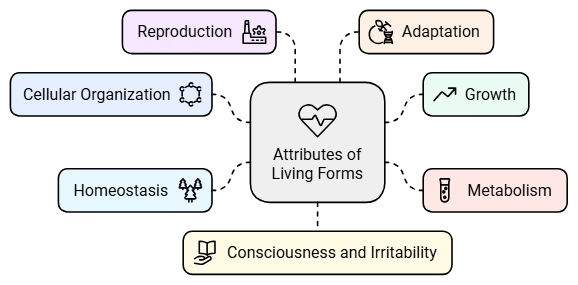
Classification of Living World
Each living being, whether plant, animal, or microorganism, is unique. This uniqueness forms the basis of diversity among living organisms.
- Biodiversity: Refers to the diverse or varied forms of living beings that differ from one another.
- Taxonomy or Systematics: The science of classification that projects the relationship between the diversity of organisms.
- Taxon: A group of any rank that is sufficiently distinct to be worthy of being assigned a definite category.
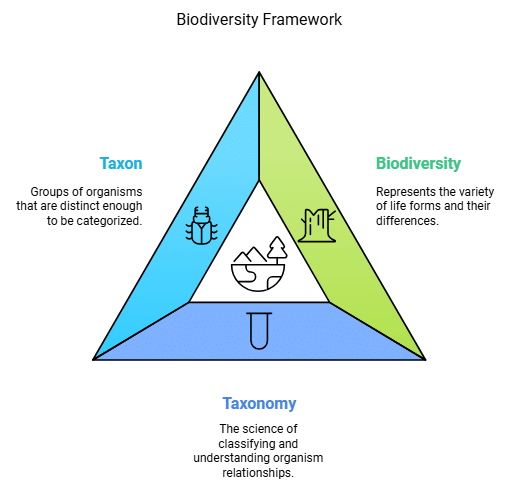
Binomial Nomenclature and Classification
Binomial nomenclature is a system of naming organisms that was introduced by Carolus Linnaeus in 1753 in his book 'Species Plantarum.' In this system, the name of an organism consists of two parts, known as epithets:
- Generic epithet : This part indicates the genus to which the organism belongs. For example, in the name Mangifera indica, Mangifera is the generic epithet.
- Specific epithet : This part refers to the specific species within the genus. In the same example, indica is the specific epithet.
- Scientist's name : This is the initial of the scientist who named the organism. For instance, in Mangifera indica, L stands for Linnaeus, the scientist who named it.
Five-Kingdom System of Classification
Proposed by Robert H. Whittaker in 1959, the Five-Kingdom System divides all organisms into the following kingdoms:
- Kingdom Monera: Consists of prokaryotic organisms, including Archaebacteria and Eubacteria.
- Kingdom Protista: Comprises unicellular eukaryotic organisms, including protozoans and algae.
- Kingdom Fungi: Simple non-green plants, heterotrophic and eukaryotic organisms, including decomposers.
- Kingdom Plantae: Multicellular eukaryotic organisms with membrane-bound cell organelles.
- Kingdom Animalia: Eukaryotic cells with heterotrophic nutrition and a variety of organizational levels.
Classification of Kingdom- Plantae
Plants, classified in Kingdom Plantae, are multicellular, photoautotrophic, and embryo-forming organisms. They play a crucial role in ecosystems by fixing solar energy through photosynthesis. Kingdom Plantae is further divided into divisions:
- Division Algae (alga-Sea weed): Consists of non-differentiated plant bodies, typically found in water, and containing various pigments for photosynthesis.
- Division Bryophyta (bryon-a moss, a liverwort): Small multicellular green land plants, including liverworts and mosses, with no true vascular system.
- Division Pteridophyta (pteruis-idos-ferns): Found in shady and damp places, with a well-defined vascular system and sporophylls.
- Division Gymnosperms (gymno-naked; sperma-seed): Primitive seed plants with naked seeds and aggregated sporophylls forming cones.
- Division Angiosperms (angeion-case; sperma-seed): Highly evolved plants producing seeds enclosed within fruits, with reproductive organs aggregated in flowers.
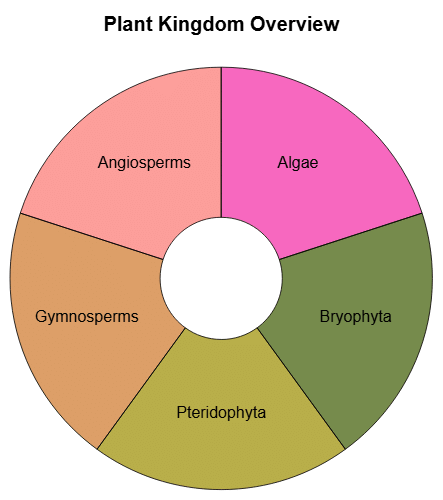
Major Differences between Dicotyledons and Monocotyledons
Plant Classification Based on External Characters
Plants are classified into three categories based on their external characteristics:
- Herbs: Green and softer stems, smaller in size.
- Shrubs: Branches arise from the base of the stem, hard but not thick stems.
- Trees: Very tall with hard and thick stems (trunks), branches arise from the upper part of the stem.
Parts of the Plant
Plants consist of four main parts:
- Root: Underground non-green part providing anchorage. Types of root systems:
- Tap root system: Prominent tap root with smaller lateral roots.
- Fibrous root system: Extensive network of similar-sized roots, e.g., rice, grasses.
- Adventitious roots: Similar-sized roots arising from different places apart from the base of the stem.
- Stem: Ascending part of the plant above the soil, bearing leaves, flowers, and other structures. Types of stem modifications:
- Underground Modifications: Food storage and thickening, e.g., stem tuber (potato), bulb (onion), corm (gladiolus), rhizome (ginger).
- Sub-aerial Modifications: Above-ground but not completely formed, e.g., runner (gram), stolon (mint), offset (water hyacinth), sucker (roses).
- Aerial Modifications: Completely aerial, e.g., stem tendril (grapes), stem thorn (lemon), phylloclade (cactus), bulbils (ruscus).
- Leaves: Contain photosynthetic pigments and perform photosynthesis. Types of venation:
- Reticulate venation: Net-like pattern on both sides of the midrib, e.g., most dicots.
- Parallel venation: Veins parallel to the midrib and to each other, e.g., most monocots.
- Flowers: Reproductive parts of the plant that maintain generation. Parts of a flower:
- Sepals: Small leaf-like structures that protect the flower.
- Petals: Brightly colored to attract insects for pollination.
- Stamen: Male reproductive part consisting of anther (produces pollen) and filament.
- Carpel/Pistil: Female reproductive part consisting of stigma (sticky part), style (stalk), and ovary (contains ovules).
- Fruits: Ripened ovary of a flower, classified into types:
- Simple fruits: Develop from a single ovary, e.g., mango, apple.
- Aggregate fruits: Develop from multicarpellary or polycarpellary apocarpous ovaries, e.g., raspberry, blackberry.
- Composite fruits: Develop from a complete inflorescence, e.g., pineapple, fig.
- Seeds: Ripened ovule containing the embryo. Types of seeds:
- Non-endospermic (exalbuminous) seeds: Embryo consumes all endosperm, e.g., most dicots.
- Endospermic (albuminous) seeds: Endosperm persists in the mature seed, e.g., most monocots and some dicots.
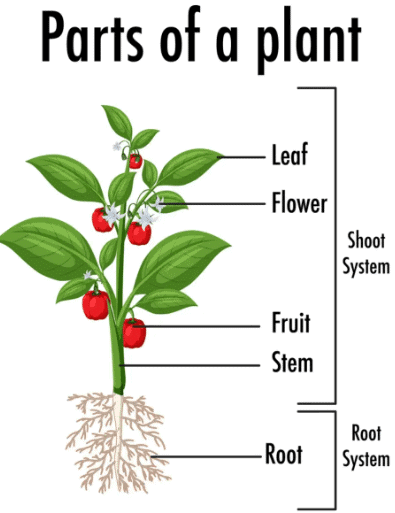
Nutrition in Plants
Nutrition in plants refers to the way they obtain and utilize food for their growth and development. Plants are primarily autotrophic, meaning they produce their own food using sunlight, carbon dioxide, and water through the process of photosynthesis. However, some plants also exhibit heterotrophic nutrition, where they rely on other organisms for their nutritional needs.
Types of Nutrition in Plants
- Autotrophic Nutrition: This is the process by which plants make their own food from simple substances like carbon dioxide and water using sunlight. The most common method of autotrophic nutrition is photosynthesis, where plants use sunlight to convert these raw materials into glucose and oxygen.
- Heterotrophic Nutrition: Some plants cannot produce their own food and rely on other organisms for nutrients. This type of nutrition includes several subcategories:
- Parasitic Nutrition: In this mode, plants obtain nutrients from other plants by attaching themselves to the host plant. An example of a parasitic plant is the Cuscuta, also known as dodder, which wraps around its host and absorbs water and nutrients.
- Insectivorous Nutrition: These plants capture and digest insects to obtain essential nutrients, particularly nitrogen. Examples of insectivorous plants include Sundew, Bladderwort, and Nepenthes, which have specialized adaptations to trap and digest insects.
- Saprotrophic Nutrition: Some plants, like mushrooms and bread mould, absorb nutrients from dead and decaying organic matter. They play a crucial role in decomposing and recycling nutrients in the ecosystem.
- Symbiotic Nutrition: This type involves a mutually beneficial relationship between plants and other organisms. For instance, lichens are a partnership between fungi and algae, where both partners benefit from the association.
- Rhizobium: Rhizobium is a type of bacteria that plays a vital role in the nitrogen cycle by converting atmospheric nitrogen into soluble forms that plants can absorb. This process occurs within the root nodules of leguminous plants, where Rhizobium bacteria form a symbiotic relationship with the plant roots. The bacteria provide the plants with nitrogen, an essential nutrient, while the plants supply the bacteria with carbohydrates and other organic compounds.
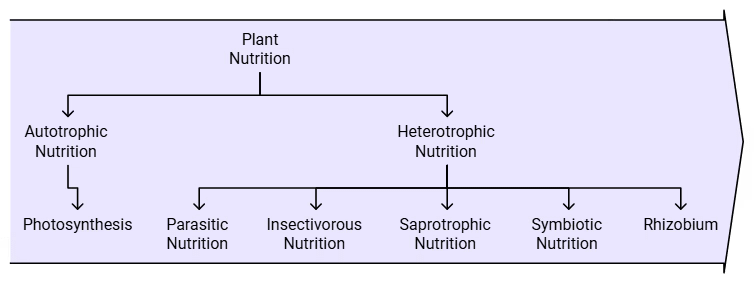
Mineral Nutrition in Plants
Plants absorb minerals from the soil in the form of ions and incorporate them into vital biomolecules. Essential elements for plant growth can be classified as:
- Macroelements are needed in large quantities and include Carbon (C), Hydrogen (H), Oxygen (O), Nitrogen (N), Sulfur (S), Phosphorus (P), Potassium (K), Magnesium (Mg), and Calcium (Ca).
- Microelements are required in smaller amounts, such as Zinc (Zn), Copper (Cu), Manganese (Mn), Iron (Fe), Boron (B), Chlorine (Cl), and Molybdenum (Mo).
Respiration in Plants
Respiration is how plants break down food in their cells to release energy. There are two types of respiration:
- Aerobic Cell Respiration : This happens when oxygen is present. During this process, glucose is fully broken down into carbon dioxide (CO2), water (H2O), and energy.
- Anaerobic Cell Respiration : This occurs when there is no oxygen. In this case, glucose is not fully broken down and is mainly converted into ethanol (C2H5OH) and carbon dioxide (CO2), along with energy.
The basic reaction for cellular respiration is:
C6H12O6 + 6O2 → 6CO2 + 6H2O + Energy
The energy released during this process is used by plants to create other necessary molecules for the cell.
Transportation in Plants
Plants transport water and minerals to the leaves through vascular bundles, which consist of xylem and phloem:
- Xylem: Transports water from roots to leaves.
- Phloem: Transports food from leaves to all parts of the plant.
Root hairs increase the surface area of roots for better absorption of water and mineral salts. A suction force due to transpiration pull helps in the upward movement of water from the soil.
Transpiration in Plants
Transpiration is the evaporation of water from plants, mainly through stomata in leaves:
- Plants have adaptations to reduce excess transpiration, such as thick waxy cuticles, modified thorn-like leaves, or even no leaves (xerophytes).
Reproduction in Plants
Reproduction in plants involves the production of offspring, which can occur via:
- Asexual Reproduction: Involves vegetative propagation where new plants develop from roots (e.g., ginger), stems (e.g., rose), or leaves (e.g., Bryophyllum).
- Sexual Reproduction: Involves the fusion of male and female gametes, produced by flowers, through processes like pollination and fertilization.
Pollination
Pollination is the transfer of pollen grains from the anther to the stigma:
- Self-pollination: Pollen is transferred to the same flower.
- Cross-pollination: Pollen is transferred to another flower of the same or different plant.
- Agents of pollination include wind, water, insects, birds, and bats.
Fertilisation and Dispersal
Fertilisation leads to the formation of seeds and dispersal ensures wider distribution:
- Fertilisation: Fusion of male and female gametes to form a zygote, which develops into an embryo.
- Dispersal: Scattering of seeds by wind, water, animals, or through explosive mechanisms to avoid competition and inhabit new areas.
Excretion in Plants
Plants eliminate waste products and excess substances in the following ways:
- Oxygen is released as a byproduct of photosynthesis.
- Excess water is released as water vapor through transpiration.
- Plants do not have specific excretory organs; waste gases like oxygen and carbon dioxide are exchanged through small pores on leaf surfaces.
- Excess salts are deposited in various plant parts, sometimes altering taste, e.g., quinine crystals in orange peel.
Classification of the Kingdom Animalia
General Characteristics
Animals are eukaryotic, multicellular, heterotrophic organisms without cell walls. They are divided into two branches: Parazoa (loosely aggregated cells) and Eumetazoa (cells arranged into tissues and organs).
Eumetazoa are further classified based on:
- Number of germ layers in the embryo
- Symmetry of the body
- Origin of the mouth
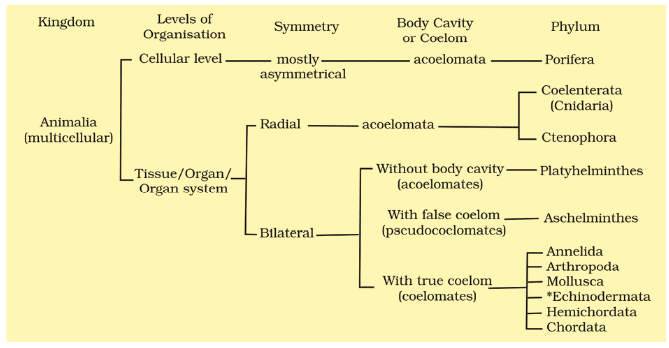
Germ Layers and Symmetry
- Diploblastic: Two germ layers in the embryo
- Triploblastic: Three germ layers in the embryo
- Bilateral Symmetry: Mirror-image symmetry
- Radial Symmetry: Regular pattern around a central axis
Origin of Mouth
- Protostomia: Mouth arises from or near the blastopore
- Deuterostomia: Mouth arises anteriorly at a distance from the blastopore
Body Cavity (Coelom)
- Acoelomates: These animals do not have a body cavity; their body is filled with tissue. Examples include flatworms.
- Pseudocoelomates: In these animals, the body cavity is not formed from mesodermal tissue. The cavity is located between the mesoderm and the endoderm. Examples include roundworms.
- Coelomates: These animals have a true body cavity formed from mesodermal tissue. The coelom is lined with epithelial cells. Examples include annelids, mollusks, and vertebrates.
 Diagrammatic sectional view of : (a) Coelomate (b) Pseudocoelomate (c) Acoelomate
Diagrammatic sectional view of : (a) Coelomate (b) Pseudocoelomate (c) Acoelomate
Phylum – Porifera (Sponges)
Sessile, marine animals with cellular level of body organization and radial symmetry. They have a canal system for filter feeding, perforated with numerous pores (ostia) and large-sized outlets (oscula). Skeleton made of calcareous or siliceous spicules. Reproduce asexually by budding and gemmules, and sexually by fertilization.
Phylum – Cnidaria (Coelenterata)
Aquatic, marine animals with tissue level of organization and radial symmetry. They possess nematocysts (sting cells) and show polymorphism with two main forms: polyps (sedentary) and medusae (free-swimming).
Phylum – Ctenophora (Comb Jellies)
Transparent, marine animals with biradial symmetry, triploblastic organization. They have tentacles and ciliary plates for locomotion. Colloblasts (adhesive cells) are present and no polymorphism is observed.
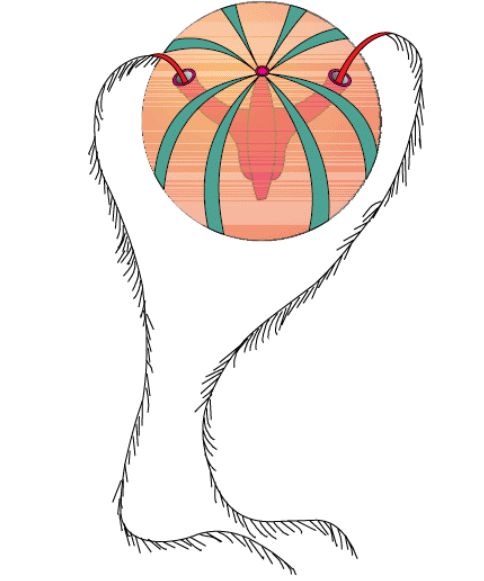 Example of Clenophora
Example of Clenophora
Phylum – Platyhelminthes (Flatworms)
Bilaterally symmetrical, flat animals with organ level of organization. They are triploblastic, acoelomate with a digestive cavity but no anus. Hermaphrodites with excretion via flame cells. Includes free-living and parasitic species.
Phylum – Aschelminthes or Nematoda (Roundworms)
Bilaterally symmetrical, unsegmented animals with pseudocoelomate body plan. They have a complete alimentary canal, lack respiratory and circulatory systems. Excretion occurs through renett cells. Includes many pathogenic species.
Phylum – Annelida (Segmented Worms)
Triploblastic, bilaterally symmetrical, elongated, segmented animals with metamerism. They have a complete alimentary canal, true coelom, and excretion via nephridia. Includes various marine and terrestrial species.
Phylum – Arthropoda (Jointed-legged Animals)
Triploblastic, bilaterally symmetrical, segmented animals with jointed appendages and an exoskeleton. They have a complete alimentary canal, open circulatory system, and excretion via Malpighian tubules. Largest phylum with diverse species including insects, crustaceans, and arachnids.
Phylum – Mollusca (Molluscs)
Triploblastic, bilaterally symmetrical, soft-bodied animals with a hard shell. They have a haemocoel body cavity, open circulatory system, and excretion via metanephridia. Includes species like snails, clams, and squids.
Phylum – Echinodermata (Echinoderms)
Triploblastic, coelomate animals with pentamerous symmetry as adults. They have a unique water vascular system for locomotion and respiration, a complete digestive system, and no excretory organs. Includes sea stars, sea urchins, and sea cucumbers.
Phylum – Chordata (Chordates)
Characterized by dorsal nerve cord, notochord, and pharyngeal gill slits. They have a segmented body with a cartilaginous endoskeleton, complete digestive system, and kidneys for excretion. Includes Urochordata (tunicates), Cephalochordata (amphioxus), and Vertebrata (vertebrates).
Subphylum – Urochordata
Marine animals with a notochord present in the larval tail, and a dorsal tubular nerve cord. Hermaphroditic with a simple body structure.
Subphylum – Cephalochordata
Marine animals with a notochord and nerve cord extending the length of the body, and a large pharynx perforated by gill slits. Sexes are separate and lack exoskeleton, head, jaws, and paired fins.
Subphylum – Vertebrata
Animals with a vertebral column replacing the notochord, and a cranium surrounding the brain. They have an endoskeleton of cartilage or bone, a ventrally situated heart, and kidneys for excretion.
Superclass Pisces (Fishes)
Fishes are exclusively aquatic, cold-blooded animals with backbone, gills, and fins. Their body is divided into head, trunk, and tail. They have a two-chambered heart and are anamniotes, lacking an extra embryonic membrane (amnion).
- Body may or may not be covered by scales.
- Examples include flying fish (Exocoetus), Labeo (rohu), shark, electric ray, and sting ray.
Superclass Tetrapoda
Class Amphibia
Amphibians are cold-blooded animals that are anamniotes. Their skin may be smooth or rough and moist due to glands. They have gills in the larval stage and use lungs, buccopharyngeal cavity, and skin for respiration. Their heart is three-chambered, and they undergo metamorphosis with iodine or salinity being essential for the transformation from tadpole to frog.
- Examples include Rana tigrina (common frog) and Hyla (tree frog).
Class Reptilia (Creeping Vertebrates)
Reptiles are cold-blooded (ectothermal) vertebrates with epidermal scales. They respire through lungs, most having a three-chambered heart, except crocodiles which have a four-chambered heart. Fertilization is internal, and they generally have teeth except for tortoises and turtles.
- Examples include Draco, Chamaleon, Python, and Naja.
Class Aves (Birds)
Birds are warm-blooded tetrapods with various flight adaptations. They have feathers covering most of their body, and forelimbs modified into wings (except in flightless birds like kiwis). Their alimentary canal has a crop and gizzard, and they have a four-chambered heart. Birds have a beak instead of jaws, exhibit sexual dimorphism, and are oviparous.
- Examples include Gallus (chicken), Passer (house sparrow), and Corvus (crow).
Class Mammalia (Mammals)
Mammals are warm-blooded (endothermic) and the most evolved animals in the animal kingdom. They have hairs and a subcutaneous fat layer for insulation, and their body is divided into head, neck, trunk, and tail. Females have milk-producing mammary glands for the nourishment of their young. Mammals have thecodont and heterodont teeth, a dicondylic skull, and two pairs of pentadactyl limbs. They respire through lungs only, excrete urea, have a four-chambered heart, and non-nucleated biconcave red blood cells. Mammals are viviparous, and parental care is highly developed.
- Examples include Macropus (kangaroo), Sorex (shrew), Panthera (lion, tiger, leopard), Rattus (rat), Macaca (monkey), and Homo (human).
|
35 videos|145 docs|32 tests
|
FAQs on Notes: Living World - Science & Pedagogy Paper 2 for CTET & TET Exams - CTET & State TET
| 1. What are the main characteristics used to classify living organisms? |  |
| 2. How is the Kingdom Plantae classified? |  |
| 3. What are the essential parts of a plant and their functions? |  |
| 4. How do plants obtain nutrition? |  |
| 5. What is the process of reproduction in plants? |  |
















